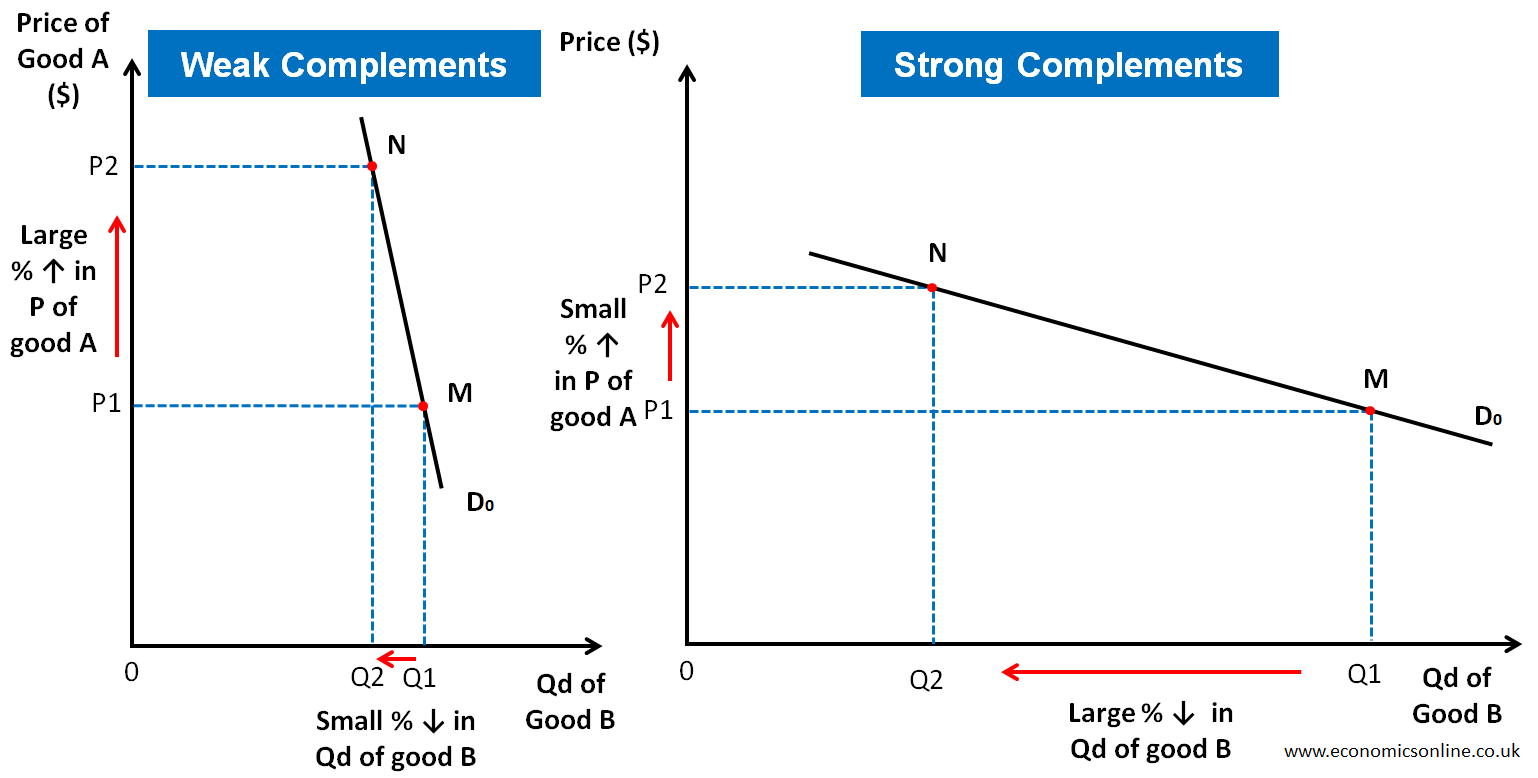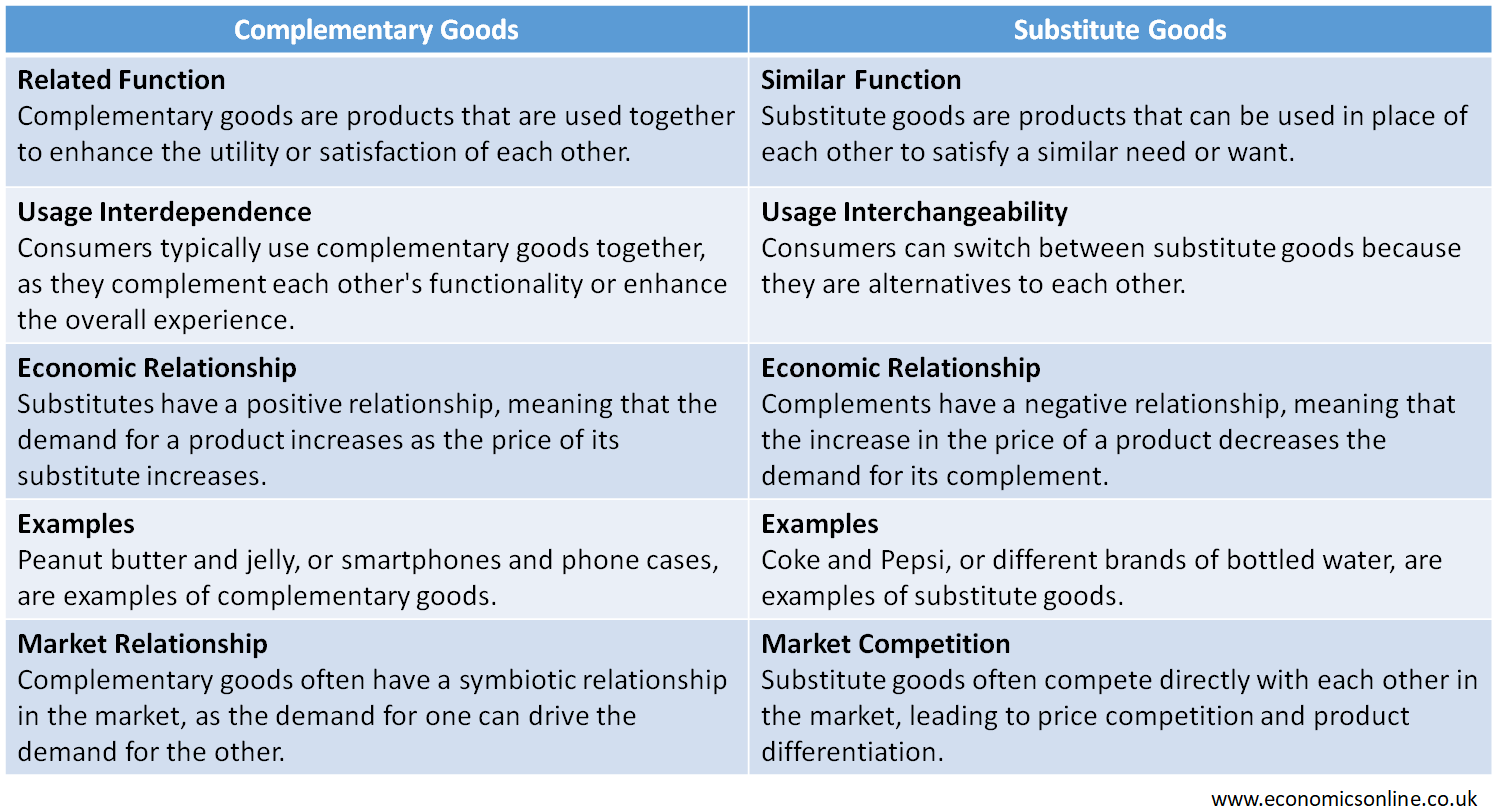
An image of a hand refilling petrol in a car.
Complements Economics
What are Complements?
Complements or complementary goods, refer to the products that are used or consumed together. These are jointly-demanded goods. In simple words, if two goods are used by consumers together, then they are called complements. Complementary goods enhance the value or utility of each other. If two goods are complements, then one is less useful without the other.
Complements Examples
There are so many examples of complementary goods around us. Some examples are given below:
- Car and petrol
- Tooth paste and tooth brush
- Pen and ink
- Printer and printer ink cartridge
- Mobile and charger
- TV and its remote
- Tennis rackets and tennis balls
- Bread and butter
- Book and bookmark
- Fishing rod and bait
- Laptop and laptop sleeves
- Camera and camera lens
- Smartwatch and its charging cable
- Gaming console and its controller
- Running shoes and socks
- Sewing machine and sewing needles
- Alarm clock and batteries
- Kitchen knife and cutting board
- Firewood and fire starter
- Pen and paper
- DVD player and DVD discs
- Pasta is pasta sauce
- Fries and ketchup
- iPhone and iPhone Apps.
- Sandwich and tomato ketchup
Complements Explanation
The complements in economics are those kinds of goods that are consumed at a time or along with one another. If the demand for one product increases, the demand for another complementary product also increases. This means that complementary goods are dependent on each other. For example, if the demand for cars increases in the market, this automatically triggers the demand for petrol in the market.
Complements Graphs
Considering two complementary goods, petrol and cars, the economic relationship between the price of petrol and the quantity demanded for cars is negative, as illustrated by the following graphs:

In the above diagram, we have two graphs illustrating the economic relationship between two complementary goods, petrol and cars. In the left graph, we have the market for petrol. In this scenario, if the supply of petrol is decreased from S0 to S1, the price of petrol increases from P0 to P1, and the quantity traded will decrease from Q0 to Q1. In the right graph, we have the market for cars. In this scenario, there is a leftward shift of demand for cars (complement of petrol) from D0 to D1 due to an increase in the price of petrol. The price of cars decreases from P0 to P1, the quantity traded also decreases from Q0 to Q1.
In this situation, petrol and cars are complementary goods and people are buying fewer cars due to an increase in the price of petrol.
Cross Elasticity of Demand (XED)
The degree of responsiveness of quantity demanded of one good to the change in the price of another good is called cross elasticity of demand (XED) or cross price elasticity of demand.
XED is calculated by using the following cross-price elasticity of demand formula:
Cross Elasticity of Demand (XED) = % Change in Qd of Product A / % Change in Price of Product B

In economics, the relationship between any two goods can be explained by using the concept of cross elasticity of demand (XED).
Complementary goods have a negative cross elasticity of demand. This explains why, when the price of a good increases, the demand for its complementary good decreases because the bundle of two complementary goods has become expensive. Similarly, when the price of a good decreases, the demand for its complementary good increases.
Here are some important points:
- A positive value of XED means that the goods are substitutes.
- A negative value of XED means that the goods are complements.
- A zero value of XED means that the goods are unrelated.
XED Example
Let’s continue with the same example of petrol and cars as complements and calculate XED as an example. Suppose that a 10% price increase in petrol leads to a 20% fall in the demand for cars.
In this case, XED = -20%/+10% = -2
This negative cross-price elasticity of demand indicates that petrol and cars are complements.
Strength of Complements
The numerical value of XED with the negative sign shows the strength of complements. A higher negative value of XED means weak or non-essential complements, while a lower negative value means strong, close or essential complements. This is illustrated by the following graphs. The demand curve in each graph is a downward-sloping curve due to the negative value of cross elasticity of demand.

In the above complements graph, we have two different graphs illustrating the strength of complements. In the left graph, we have weak complementary goods or non-essential complements. The price of good A is shown on the vertical axis (y-axis), while the quantity demanded of good B is shown on the horizontal axis (x-axis). The value of XED will be between zero and -1. A large percentage increase in the price of good A will lead to a small percentage decrease in the price of good B (complement).
In the right graph, we have strong, close or essential complements. The value of XED will be less than -1. A small percentage increase in the price of good A will lead to a large percentage decrease in the price of good B (complement).
The following table summarises the main features of strong and weak complements.

Substitute Goods
Substitutes or substitute goods, are the goods that are used as alternatives to each other. They are alternatively demanded goods. When a product becomes expensive, customers can switch to its substitute. A typical example of substitute goods is coffee and tea. When the price for coffee increases, some people shift their needs to tea. They started consuming tea more than coffee as a substitute for coffee. Another example of substitute goods is Coke and Pepsi.
Substitutes vs. Complements
Complementary goods (complements) are jointly demanded goods, while substitute goods (substitutes) are alternatively demanded goods. A complementary good is a good that adds value to another, or a good that cannot be used without another good, while in case of a substitute, the good can be used alternatively to satisfy the same need or want. Complements cross price elasticity is negative, while, substitutes have a positive cross-price elasticity of demand.
The following table contains the main points of difference between complementary goods and substitute goods in order to explain the concept of substitutes vs. complements.

How Firms Use Complementary Goods
The following are some points on how firms use complementary goods for their own benefit:
Bundling
Companies use the strategy of bundling to create an illusion of value for buyers or consumers. This bundling strategy increases their sales. For example, a mobile phone company may provide a free phone case with the purchase of a new mobile phone. Similarly, firms offer bundle deals for other complementary goods like gaming consoles and controllers.
Cross-Promotion
Companies cooperate with complementary goods or service providers and promote their goods or services through cross-promotion. Companies promote their products with the benefit of other companies offering complementary goods or services just like theirs. Companies sign contracts to play the same card in the market. For example, telecom companies cross-promote their service packages with particular mobile phones.
Product Integration
Companies tend to produce those goods or services that can easily integrate with the other complementary goods or services in the market. Companies are now shifting their trends to product integration, through which consumers or users can experience ease or a sense of comfort. For example, companies that provide subscription services for different online platforms provide apps to their users so that they can easily integrate and check their subscription status through their app.
Merchandising
Merchandising refers to the efforts of firms to influence buyers at the point of sale. Retailers place complementary goods in shelves close to each other. This improves the ease of shopping for customers and overall sales of retailers.
Base Products
Some firms sell base products at a low price in order to make customers loyal, who will buy expensive complements later. For example, Gillette offers its shaving razors (the base product) at a lower price. Once customers become loyal, they have to replace razor blades, which are offered at a higher price. Similarly, Accu-Chek may offer its blood sugar monitors at a lower price. Once customers get loyal, they have to buy test strips at a higher price. In this way, companies not only sell their add-on items but also increase their overall sales.
Conclusion
In conclusion, complementary goods are the goods that are used together by consumers. The cross elasticity of demand for complements is negative. Firms should remain vigilant about the impact of changes in the prices of complements because their price change can influence the demand for their products. Firms can use complements to their benefit by using various strategies such as bundling, merchandising, and cross-promotions.


